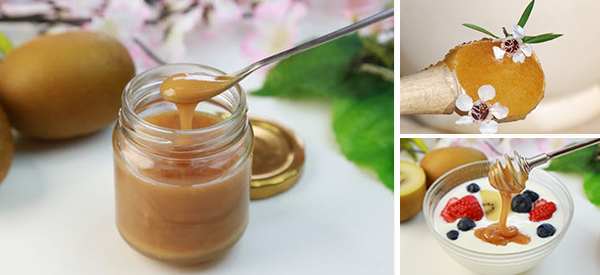
When And How To Use Manuka Honey
Not all honey is the same. You may have heard this multiple times, but you’re still clueless as to how it can affect your health. While we all know that honey is generally healthy for us, various kinds of honey have different levels of outcome to our well-being. Hence, before you decide to pick what’s in store and add it to your diet, make sure that you are acquainted with this amazing Manuka Honey.
What Is Manuka Honey?
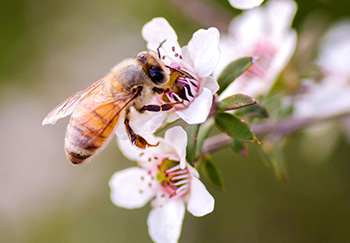 What is manuka honey and what makes it different? Few people are aware of manuka honey’s existence. But for those who do, they can tell you right away that this honey is special.
What is manuka honey and what makes it different? Few people are aware of manuka honey’s existence. But for those who do, they can tell you right away that this honey is special.
Manuka honey is honey native to New Zealand. It is specifically produced by bees that pollinate the plant called manuka bush. Experts say that manuka honey is one of the best types of honey. Rich and earthy in taste, manuka honey is a great addition to your diet. Like all kinds of honey, manuka honey is naturally sweet too so you can use it as an alternative sweetener.
However, what makes manuka honey different from other honey is its antibacterial properties. The antibacterial components are more potent due to the high concentration of methylglyoxal (MGO). MGO allows manuka honey to help with different health problems you may have. It has antiviral, antioxidant, anti-inflammatory, and antimicrobial properties as well.
Benefits of Manuka Honey for Health and How to Use it for Each Problem
Wound Healing
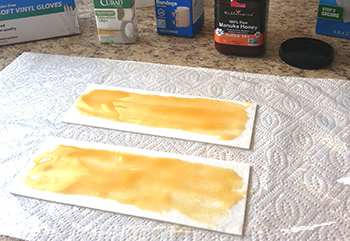 The wound healing properties of manuka honey make it a great remedy for minor scrapes and cuts. But for severe wounds, consult your doctor accordingly for better wound assessment.
The wound healing properties of manuka honey make it a great remedy for minor scrapes and cuts. But for severe wounds, consult your doctor accordingly for better wound assessment.
To use: Assess the wound to see if the fluid is leaking from it. The more fluid leaks your wound has, the more amount of honey you should use. Put an ample amount of honey on a bandage, and cover the wound with the honeyed-bandage. Do not apply manuka honey directly to the wound. Change the dressing as often as needed, especially when leaks are too much.
Sore Throat
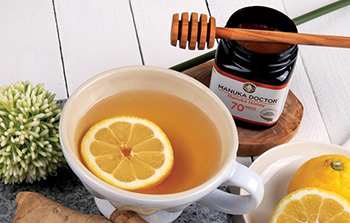
Manuka honey is best for sore throat prevention. If you are already suffering from the infection, taking this honey can help alleviate your symptoms.
To use: Take 1 tablespoon of manuka honey with warm water every day. You may also mix it with warm water laced with lemon juice for better effect.
Acne
Thanks to its antimicrobial and anti-inflammatory properties, manuka honey is an effective home remedy for acne problems.
To use: Wash your face with warm water. Pat dry. Cover your face with a thin layer of manuka honey, and leave it on for 15-20 minutes as you would with other face masks. Rinse well to remove any sticky residue.
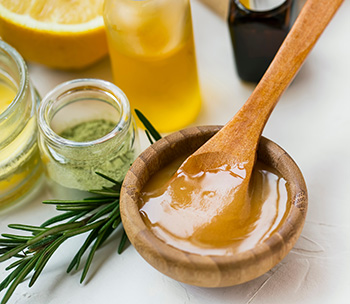
Eczema
Among honey, manuka honey has the strongest antibacterial properties that can kill Staphylococcus aureus, a bacteria most often found in people with eczema.
To use: Mix equal parts of honey, beeswax, and olive oil. Apply the paste to the affected area three times a day.
Related: How To Treat Eczema Naturally
Improves Digestive Health
Some studies show that manuka honey helps alleviate symptoms and improve overall digestive health. It helps with constipation, diarrhea, gastric ulcers, and irritable bowel syndrome (IBS), among many other digestive concerns.
To use: Take 1-2 tablespoons of manuka honey every day.

You can either eat it directly from a spoon or include it on your food or beverage as an alternative sweetener.
When adding it to a tea, however, make sure that you add it after you remove the teabag or when it has cooled slightly. This is to protect the healthy enzymes of manuka honey from the heat.
Knowing Your Manuka Honey
Due to commercialization, many manufacturers commercialized it. Yet, not all products have the same level of concentration nor are they effective to use. Knowing the grading system of manuka honey will help you determine whether you can trust the honey you see in the store or not.
The UMF, otherwise known as the Unique Manuka Factor, is the standard used worldwide to know and gauge the antibacterial strength of the honey. In a nutshell, here are the UMF grades you should look out for in labels of manuka honey products.
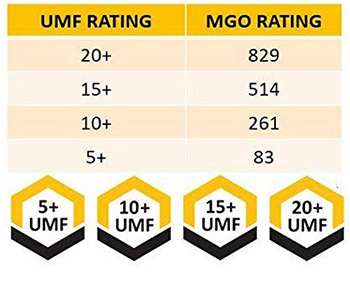 0-4: Does not provide any therapeutic effects
0-4: Does not provide any therapeutic effects
4-9: Offers the same health benefits as regular honey
10-14: Sustains healing and provides a good dose of antibacterial properties
15+: Highly therapeutic manuka honey, but needs to be limited to 1 tablespoon of intake
Manuka honey is more expensive than regular honey because it provides up to 4 times more nutrition than other honey types. But the next time you hit the shelf, check the label first and make sure you get the manuka honey with a good UMF rating.
Risks and Warnings
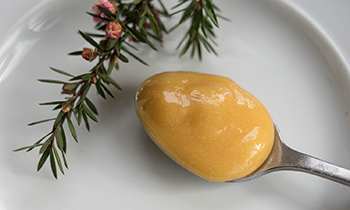 I understand many of you might want to try manuka honey, especially after knowing the amazing benefits it has to offer. But there are also precautions that I want to reiterate when using this honey. While honey is mostly safe to consume for everyone, those who are on the lookout for their blood sugar levels must be cautious. Diabetics, in particular, need to consult their doctors before adding manuka honey to any of their foods and beverages.
I understand many of you might want to try manuka honey, especially after knowing the amazing benefits it has to offer. But there are also precautions that I want to reiterate when using this honey. While honey is mostly safe to consume for everyone, those who are on the lookout for their blood sugar levels must be cautious. Diabetics, in particular, need to consult their doctors before adding manuka honey to any of their foods and beverages.
If you have any known previous allergic reactions to any forms of honey, it is best to avoid it as well. Moreover, do not feed manuka honey to infants under 12 months old as it can lead to an increased risk of botulism poisoning.
Additionally, if you are taking some medications, please consult your doctor for advice. Manuka honey can interact with some known drugs. So it is best to get your physician’s advice before consuming it.
Final Thoughts
Manuka honey is one – if not the best – type of honey known to man. It may be more expensive than the regular honey, but getting one is worth it. Just make sure that you check the UMF of the manuka honey you want to purchase. After all, you do not want to buy a useless product that does not maximize the benefits of manuka honey.
Also, take note of the risks and warnings. Don’t forget to consult your doctor for advice.
You may also like:
50 Amazing Uses For Honey You Didn’t Know About
Do This Before Going to Bed To Rebuild Your Gums (Video)


in your description of how to use manuka honey it first instructs you to ;”” Put an ample amount of honey on a bandage, and cover the wound with the honeyed-bandage. Do not apply manuka honey directly to the wound.
then the next sentence it says do not apply directly to the wound .?? so how are we to apply the bandage with the honey on the outside, ??please have someone check the readability before sending out to readers.
Hi! Sorry for the miscommunication. What I meant was to apply it first on the bandage. Then put the bandage with the honey side touching the wound. Do not apply the honey directly on the wound and cover it with the bandage afterwards as it can be messy. I apologize for the confusion.
I understood clearly that you don’t put the honey straight on the wound. You put the honey on a dressing then put the dressing on the wound. I think it’s clear enough.
I agree. It’s not difficult to understand at all. Lol some people just want to be difficult. Great Read
I agreed, touching or not touching ?
I researched Manuka honey after reading this and its the sterilized version that’s used on wounds and burns.
I tried Manuka honey in N Z.
N Z protects the environment.
They even cleaned our hiking boots on arrival so we did not bring foreign microbes on out boots. Hurrah for N Z@
I have used Manuka honey for awhile now and have always wondered about the best was to soften / melt it for use without hurting its beneficial properties.
Hi LW,
Thank you for your comment.
You can place the glass jar of Manuka Honey into a larger glass jar/bowl.
Place warm water (95 F -115 F) inside the bowl where the Manuka Honey jar is sitting. Make sure the water is above the level of the honey but below the lid.
Leave the jar of honey sitting in the warm bath, stirring occasionally until you get the disired consistency.
For using it for paste for eczema. do you melt the ingredients together to make the paste? you did not say
Hi Patti,
I’m sorry for the confusion.
You can melt the beeswax with the oil first. Then remove it from heat, and let it cool for a bit. That’s the time you have to add the manuka honey.
You didn’t mention the amazing use of manuka honey, which is for bed sores. I learned this from nurses. It seems to be the best, maybe the only thing that can cure them. It is from new zealand tea tree flowers.
.
Where this be purchased? And how do we determine when we are shopping for it if it’s authentic.
Hi Regina,
Manuka honey used to be hard to find outside of New Zealand. But thanks to its growing popularity, today you can buy this honey at many natural and grocery stores throughout the United States (Costco, Walmart, and Whole Foods Market) You can also find it online:
https://www.walmart.com/c/ep/manuka-honey
https://www.manukanatural.com/manuka-honey/
https://www.comvita.com/
Look for real active manuka honey that is UMF® Lab Tested, UMF® Certified, and UMF® Licensed.
The higher the UMF rating, the more antibacterial activity manuka honey has — and the more potent it is.
Thank you!
I too would like to know where to purchase.
Hi Kristen,
You can buy this honey at many natural and grocery stores throughout the United States (Costco, Walmart, and Whole Foods Market) You can also find it online:
https://www.walmart.com/c/ep/manuka-honey
https://www.manukanatural.com/manuka-honey/
https://www.comvita.com/
The higher the UMF rating, the more antibacterial activity manuka honey has — and the more potent it is.
Good morning, I have 2 questions. When you use the Manuka honey for acne, how often do you use it? 3x weekly or? 2nd question you use beeswax in some of your recipes, can you tell me what kind we are suppose to get? All natural or store bought ect.. thanks lanette
It is awesome. I had a big boil n was using charcoal. It was taking forever n made a huge mess. I put the honey on it n w in days it was gone. It’s expensive but worth it for what it can do!!!
i found Manuka honey in a high end food store along side regular honey. its a bit pricey but certainly worth it.
I found it at Sprouts, a more natural grocery store.